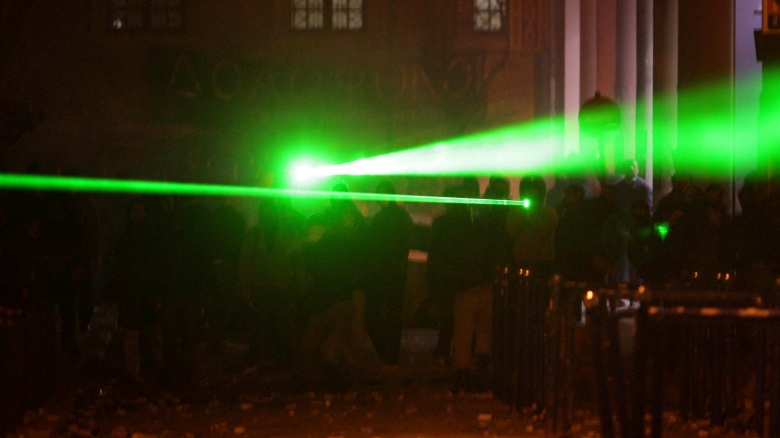The Science Behind Lightsabers
Ever since the first Star Wars movie, everyone's wanted to get their hands on a real life lightsaber. Even though it seems as though they'd only exist in our imaginations, there's plenty of science that seems to indicate that lightsabers could actually become a reality. Kinda!
How Lightsabers Work
According to Star Wars books and comics, lightsabers have many parts, but these are the really important ones: a power source and emitter to create light for the blade, a Kaiburr crystal to focus the light into a blade, a blade containment field, and a negatively charged fissure. To simplify all the technical jargon, these parts focus a beam of energy through the crystals that extends out from the hilt. That energy then arcs back on itself and returns to the negatively charged fissure in the hilt, which essentially catches the beam and makes the blade. The color of the blade depends on the crystals used, and the length depends on the power source and how long the Jedi or Sith has adjusted it to. The blade of a lightsaber can cut through virtually anything, except for another lightsaber and some substances that appear in the Expanded Universe stories. Also, they'd probably be really useful when making a grilled-cheese sandwich.
What Lightsabers Are Not
Despite the name, lightsabers don't emit beams of light. If they emitted beams of light, they wouldn't be able to cut through anything—because light can't cut through anything since it has no mass. Yes, lightsabers do give off some light by glowing, but the that glow is a side-effect more than anything else. Take a common, household flashlight for example. If light could cut through things, then every flashlight would be a deadly weapon. Which is why pretending our flashlights were lightsabers as children was ultimately very disappointing. So knowing that a lightsaber blade can't be light, what then is it? There are two possibilities: plasma and a laser.
What A Laser Is
Essentially, a laser is light focused to a very fine point. Now, we know we just said that a lightsaber is not actually a beam of light, and that's still true. A laser and a beam of light are not the same thing, technically. Consider this analogy: light is to a laser what a tree is to paper. It's one thing used to make another, but it's no longer that original thing. And there are various kinds of lasers. Some are relatively safe, like laser pointers, which can only harm a person if you shine it directly in their eye. So, those wouldn't make good lightsabers. Another kind of laser is the kind used in surgeries, like laser eye surgery, which can be used to cut. Those could be used as a basis for a lightsaber. Go technology!
How A Laser Sword Would Work
Now that we know that lasers can be used for cutting, we know that they could potentially be used as a starting point for a lightsaber, but that's where the problems begin to appear. Aside from the safety issues arising from actually using a lightsaber, there are the practicalities of how one would work, and there are a few, according to Physics.org. First, like light, lasers don't bend. They just go straight, until they connect with something. So you'd need a way to make the beam stop at some desired length, that or figure out a way to wield an infinitely long beam of death. Second, it takes a lot of energy to power a laser, more than a few D-sized batteries. We'd need a much larger power source, which brings up the third problem: size. The kind of machine needed to create a lightsaber, using lasers, that functions the way we see in the movies would be too big to carry. So using lasers to make a lightsaber is kind of out, at least until technology can catch up with our imaginations. That leaves us with plasma.
What Plasma Is
Plasma is the fourth state of matter, aside from solid, liquid, and gas. It's essentially ionized gas, and an everyday example of it is lightning. Now, as dangerous as we think of lightning to be, plasma can be harnessed—and it already has been in industrial settings. Plasma has been used to weld metals since the 1960s and has been used to cut metals, such as steel, copper, and brass, since the 1980s. Now, don't get your hopes up too much. While plasma has been used for cutting in industrial settings, it doesn't mean that workers walk around with lightsabers strapped to their hips. The plasma cutters are usually part of some large, bulky machine. And the plasma arcs that they create are pretty short, measurable in millimeters. They're miniscule compared to the three-foot blades wielded by the Jedi. Also, anyone using a plasma cutter has to wear protective eyewear at all times because of the harshness of the light they create, and not too many Jedi walked around wearing welding masks. But Darth Vader did. Did the Sith know something the Jedi didn't? Aside from how flattering wearing black all the time can be, that is.
What It Takes To Make Plasma
Making plasma seems like it'd be a bit easier than one would think. It takes anywhere between two to six kilowatt hours to power a plasma cutter, from what we've been able to find. To give you an idea of how much power that is, running a blender for an hour a day for a week uses about two kilowatts. So it's not a lot of energy. But while that may not seem like a lot, the electricity powering that blender is created by huge generators. And like we said, the plasma cutters that exist today are usually a small part of a larger, bulkier machine—a necessity in order to channel all the power needed to run a plasma cutter, and for safety issues too.
Now, even though all that's true, handheld plasma cutters do exist, but they're no more elegant or graceful than a blaster. While a handheld plasma cutter looks no different than a welding torch, the power source on it is about the size of a car battery. Add to that the fact that the power source costs thousands of dollars, we can tell that no one's going to be using one to make a lightsaber anytime soon. So it looks as though, with technology being what it is today, lightsabers can't exist. Technology fails us again. Or has it?
What Harvard And MIT Did
According to a Fox News article from September 2013, scientists at the Harvard-MIT Center for Ultracold Atoms accidentally created a lightsaber...sort of. Without going into the science of it all, scientists there found a way to create hardened light that acts kind of how lightsabers act, meaning they made light that bounces off of light. While this sounds awesome, the downside is they're not going to use this knowledge to actually make lightsabers. They're more interested in using this knowledge to move towards quantum computing. Anyone know any Bothans who might be up for stealing some information?







